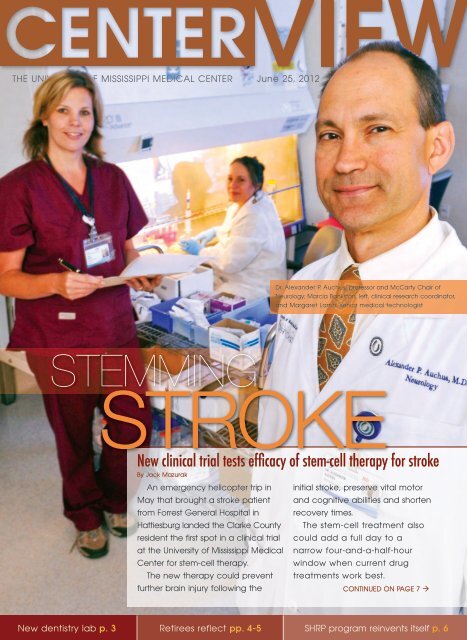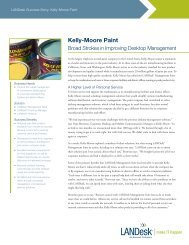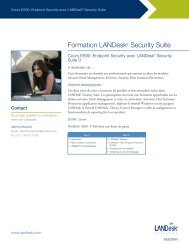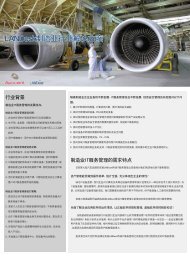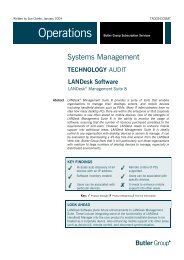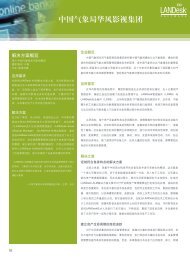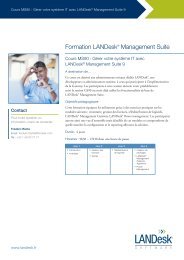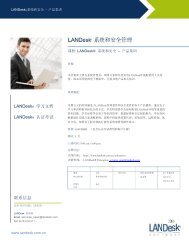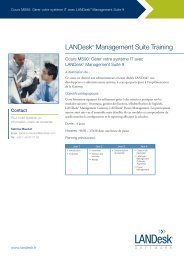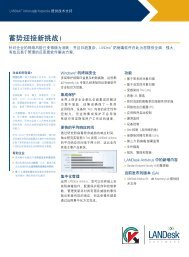Download the University of Mississippi Medical Center ... - LANDesk
Download the University of Mississippi Medical Center ... - LANDesk
Download the University of Mississippi Medical Center ... - LANDesk
Create successful ePaper yourself
Turn your PDF publications into a flip-book with our unique Google optimized e-Paper software.
THE UNivERSiTy <strong>of</strong> MiSSiSSiPPi MEdical cENTER<br />
STEMMING<br />
an emergency helicopter trip in<br />
May that brought a stroke patient<br />
from forrest General Hospital in<br />
Hattiesburg landed <strong>the</strong> clarke county<br />
resident <strong>the</strong> first spot in a clinical trial<br />
at <strong>the</strong> <strong>University</strong> <strong>of</strong> <strong>Mississippi</strong> <strong>Medical</strong><br />
center for stem-cell <strong>the</strong>rapy.<br />
The new <strong>the</strong>rapy could prevent<br />
fur<strong>the</strong>r brain injury following <strong>the</strong><br />
June 25, 2012<br />
STROKE<br />
New clinical trial tests efficacy <strong>of</strong> stem-cell <strong>the</strong>rapy for stroke<br />
By Jack Mazurak<br />
dr. alexander P. auchus, pr<strong>of</strong>essor and Mccarty chair <strong>of</strong><br />
Neurology; Marcia Bankston, left, clinical research coordinator,<br />
and Margaret lamb, senior medical technologist<br />
initial stroke, preserve vital motor<br />
and cognitive abilities and shorten<br />
recovery times.<br />
The stem-cell treatment also<br />
could add a full day to a<br />
narrow four-and-a-half-hour<br />
window when current drug<br />
treatments work best.<br />
coNTiNUEd oN PaGE 7 Ò<br />
New dentistry lab p. 3 Retirees reflect pp. 4-5 SHRP program reinvents itself p. 6
2<br />
CENTERVIEW<br />
INCIDENTMANAGED MANAGED<br />
New <strong>LANDesk</strong> system provides top-notch IT service<br />
through Epic transition . . . and beyond<br />
By Bruce coleman<br />
In <strong>the</strong> days following <strong>the</strong> <strong>University</strong> <strong>of</strong> <strong>Mississippi</strong> <strong>Medical</strong> <strong>Center</strong>’s transition<br />
to an electronic health records system, <strong>the</strong> flurry <strong>of</strong> activity that was <strong>the</strong> Division <strong>of</strong><br />
Information Systems’ Epic Command <strong>Center</strong> in <strong>the</strong> LC Building on Lakeland Drive<br />
would have reached critical mass but for a single piece <strong>of</strong> s<strong>of</strong>tware infrastructure.<br />
As <strong>the</strong> number <strong>of</strong> UMMC employee requests to <strong>the</strong> DIS Service Desk exploded<br />
from an average <strong>of</strong> 250 a day to close to 15,000 a day after <strong>the</strong> Epic switch was pulled<br />
June 1, a brand-new incident management system was given its greatest challenge.<br />
Communications flowed so smoothly that no one outside <strong>of</strong> <strong>the</strong> command<br />
center would have suspected that DIS had implemented <strong>the</strong> <strong>LANDesk</strong> incident<br />
management system a mere four days before <strong>the</strong> Epic transition had taken place.<br />
“We had a very short amount <strong>of</strong> time to get an incident management system<br />
up and ready to be able to handle <strong>the</strong> amount <strong>of</strong> resources needed for Epic,” said<br />
Brindley Kuiper, director <strong>of</strong> IT operations. “We wanted a clean system, so we<br />
started from scratch, adding people to <strong>the</strong> system and configuring it. We didn’t<br />
import anything from <strong>the</strong> old system to <strong>the</strong> new one.”<br />
According to Kuiper, <strong>the</strong> decision to convert to <strong>the</strong> <strong>LANDesk</strong> system so close<br />
to <strong>the</strong> organization-wide electronic health records implementation was bold, yet<br />
calculated.<br />
“Going into Epic created a lot <strong>of</strong> change,” he said. “We needed to be able to<br />
manage that change much more efficiently. We were using ano<strong>the</strong>r version <strong>of</strong> a service<br />
desk management tool, but it was about five or six years old. There was a need<br />
to upgrade that system due to its age and <strong>the</strong><br />
vulnerability <strong>of</strong> that system.<br />
“Knowing that Epic was<br />
coming, we thought<br />
it would be a<br />
good<br />
Chancellor<br />
<strong>University</strong> <strong>of</strong> <strong>Mississippi</strong>:<br />
dan Jones, M.d.<br />
Vice Chancellor for<br />
Health Affairs:<br />
James E. Keeton, M.d.<br />
cENTERVIEW | June 25, 2012<br />
Editor:<br />
Bruce coleman<br />
Staff Writers:<br />
Patrice Sawyer Guilfoyle,<br />
Jen Hospodor, Jack Mazurak,<br />
Matt Westerfield<br />
June 25, 2012<br />
Published by <strong>the</strong> Division <strong>of</strong> Public Affairs at <strong>the</strong> <strong>University</strong> <strong>of</strong> <strong>Mississippi</strong> <strong>Medical</strong> <strong>Center</strong><br />
Photographer:<br />
Jay ferchaud<br />
Support Staff:<br />
lynn Griffin, Peggy Wagner<br />
Chief Public Affairs and<br />
Lead Designer:<br />
To browse archives or read<br />
<strong>the</strong> most current <strong>Center</strong>View,<br />
visit <strong>the</strong> Public Affairs website<br />
Communications Officer:<br />
Tom fortner<br />
derrick dyess<br />
http://publicaffairs.umc.edu<br />
— <strong>Center</strong>View is printed by <strong>the</strong> UMMc department <strong>of</strong> Printing —<br />
For more news and information <strong>of</strong> interest to <strong>the</strong> <strong>Medical</strong> <strong>Center</strong> family, visit <strong>Medical</strong> <strong>Center</strong> News online (http://info.umc.edu/)<br />
time to look at some <strong>of</strong> <strong>the</strong> different customer service tools that were available to<br />
help us manage <strong>the</strong> EHR transition.”<br />
DIS leadership landed on <strong>LANDesk</strong>, not just for what<br />
it could provide IT staff during <strong>the</strong> Epic transition, but also<br />
for how it would help <strong>the</strong>m manage Service Desk queries<br />
in <strong>the</strong> future.<br />
<strong>Medical</strong> <strong>Center</strong> employees may continue to access <strong>the</strong><br />
Service Desk by calling 4-1145 or e-mailing servicedesk@umc.<br />
edu. But <strong>the</strong> centerpiece <strong>of</strong> <strong>the</strong> new system is a state-<strong>of</strong>-<strong>the</strong>art<br />
in-service portal that provides employees unprecedented<br />
Kuiper<br />
access to <strong>the</strong>ir Service Desk queries 24 hours a day, seven days<br />
a week.<br />
“There’s a lot <strong>of</strong> automation behind <strong>LANDesk</strong>,” Kuiper said. “One <strong>of</strong><br />
<strong>the</strong> most important aspects <strong>of</strong> this new system is <strong>the</strong> ability for end-users to<br />
log into <strong>the</strong>ir “myservicedesk” portal, where <strong>the</strong>y can log new incidents and<br />
review existing tickets without having to call or e-mail <strong>the</strong> service desk.<br />
“It’s mobile device-aware, it integrates with our o<strong>the</strong>r infrastructure<br />
technologies and it seems to be a very easy system to learn and to manage.”<br />
The portal also notifies employees <strong>of</strong> any system outages without having to call<br />
or e-mail <strong>the</strong> service desk.<br />
Kuiper said <strong>LANDesk</strong> also provides a dynamic inventory management tool that<br />
uses bar-code readers to help track inventory.<br />
“We can track inventory from <strong>the</strong> time it’s ordered until we deliver it to <strong>the</strong><br />
customer, and help manage it during its life cycle,” he said.<br />
Employees can access <strong>the</strong> portal by typing “myservicedesk” into <strong>the</strong>ir Internet<br />
address bar and entering <strong>the</strong>ir UMMC login credentials.<br />
DIS staff have embraced <strong>LANDesk</strong> with gusto. The enhanced automation<br />
allows for less hands-on ticket processing from <strong>the</strong>ir end, while UMMC employees<br />
can manage <strong>the</strong>ir own incidents and request certain s<strong>of</strong>tware installations to <strong>the</strong>ir<br />
workstation automatically. The system provides DIS staff greater access to <strong>the</strong>ir<br />
assigned incidents due to cross-platform compatibility.<br />
“We’re still in <strong>the</strong> midst <strong>of</strong> <strong>the</strong> Epic transition, and that continues to be our<br />
main focus,” said Kuiper, who noted <strong>the</strong> Epic Command <strong>Center</strong> will continue to<br />
field EHR calls well into July. “But <strong>the</strong> service desk could not have handled <strong>the</strong><br />
Epic transition as well without <strong>the</strong> conversion to <strong>LANDesk</strong>. The old system was<br />
very hardware-intensive and <strong>the</strong> extra load <strong>of</strong> incidents would have made it difficult<br />
at best to maintain a stable system.”<br />
“Going forward, <strong>LANDesk</strong> will allow us to focus more <strong>of</strong> our resources on <strong>the</strong><br />
end-user ra<strong>the</strong>r than having to manage <strong>the</strong> system.”<br />
For more information about <strong>LANDesk</strong>, visit http://servicedesk.umc.edu/.<br />
centerview, published every o<strong>the</strong>r week, is<br />
<strong>the</strong> internal publication <strong>of</strong> <strong>the</strong> <strong>University</strong> <strong>of</strong><br />
<strong>Mississippi</strong> <strong>Medical</strong> center, <strong>the</strong> state’s only<br />
academic health sciences center. content<br />
features news <strong>of</strong> interest for and about <strong>Medical</strong><br />
center faculty, staff and students. content may<br />
be reprinted with appropriate credit. ideas for<br />
stories are welcome and may be submitted<br />
by e-mail to bcoleman@umc.edu or<br />
delivered to:<br />
division <strong>of</strong> Public affairs<br />
The <strong>University</strong> <strong>of</strong> <strong>Mississippi</strong> <strong>Medical</strong> center<br />
2500 North State Street<br />
Jackson, MS 39216-4505<br />
(601) 984-1100
Restoring<br />
RENOVATION<br />
New SOD lab represents<br />
technological leap into ‘digital dentistry’<br />
By Matt Westerfield<br />
Counting those who marched in last month’s commencement, <strong>the</strong> School <strong>of</strong> Dentistry<br />
has reached a landmark by graduating more than 1,000 dentists since enrolling its<br />
first class in 1975. And virtually every one <strong>of</strong> those graduates has worked in <strong>the</strong> original<br />
restorative clinic laboratory to build crowns, bridges and dentures for <strong>the</strong>ir patients.<br />
But it’s <strong>the</strong> start <strong>of</strong> a new era at <strong>the</strong> school: Current students will learn to build <strong>the</strong>ir<br />
restorations in a newly renovated, state-<strong>of</strong>-<strong>the</strong>-art laboratory loaded with cutting-edge<br />
equipment, flat-screen TVs and a brand-new student lounge. The lab is located on <strong>the</strong><br />
fourth floor.<br />
A ribbon-cutting ceremony and reception is scheduled from 3-4:30 p.m. on<br />
Friday, July 13, in <strong>the</strong> new lab.<br />
“This is where <strong>the</strong>y spend <strong>the</strong> majority <strong>of</strong> <strong>the</strong>ir time during <strong>the</strong>ir third and fourth<br />
years,” said Dr. Larry Breeding, pr<strong>of</strong>essor and interim dean <strong>of</strong> clinical affairs. “I think that’s<br />
why we were able to get so much donor support — <strong>the</strong>y all remember working in it.”<br />
Current students who have been displaced to o<strong>the</strong>r lab space around <strong>the</strong> school<br />
during construction began using <strong>the</strong> new lab last week.<br />
Construction on <strong>the</strong> new lab began<br />
last summer, following a fundraising<br />
campaign to supplement <strong>the</strong> $2.4<br />
million price tag, much <strong>of</strong> which was<br />
funded through a state appropriation.<br />
Thanks to alumni support, <strong>the</strong> EXCEL<br />
Campaign raised more than $400,000,<br />
exceeding its original goal by $100,000.<br />
Marla Martin, director <strong>of</strong> clinical operations,<br />
said that money paid for <strong>the</strong> lab’s<br />
upgraded equipment.<br />
The new lab features 40 workstations<br />
— including four that were de-<br />
dr. larry Breeding displays <strong>the</strong> cadent<br />
signed to be compliant with Americans<br />
iTero digital impressions system. with Disabilities Act standards — a new<br />
digital CAD/CAM room, workspace<br />
solely for <strong>the</strong> dentistry technicians on staff, and a student lounge and c<strong>of</strong>fee bar overlooking<br />
<strong>the</strong> nor<strong>the</strong>ast corner <strong>of</strong> campus.<br />
The lab makeover also reflects <strong>the</strong> school’s leap into <strong>the</strong> digital age <strong>of</strong> dental<br />
restoration. Although Dr. Breeding and <strong>the</strong> staff have made some use <strong>of</strong> computer-aided<br />
design and computer-aided manufacturing technology, new equipment representing <strong>the</strong><br />
future <strong>of</strong> <strong>the</strong> industry will dramatically aid students in keeping on <strong>the</strong> forefront <strong>of</strong> digital<br />
dentistry.<br />
After 27 years <strong>of</strong> service as a faculty member, Dr. Gary Reeves was<br />
named dean <strong>of</strong> <strong>the</strong> School <strong>of</strong> Dentistry in May.<br />
Reeves, who served six years in <strong>the</strong> U.S. Army before coming to <strong>the</strong><br />
school as a student in 1980, has served as interim dean since 2010. He<br />
took <strong>the</strong> School <strong>of</strong> Dentistry helm after <strong>the</strong> previous interim dean, Dr.<br />
Butch Gilbert, retired in February 2010. Reeves is <strong>the</strong> school’s first dean<br />
since Dr. James Hupp, whose tenure lasted from 2002-08.<br />
Dr. James Keeton, vice chancellor for health affairs, said he is<br />
thrilled to have someone as respected as Reeves lead <strong>the</strong> school.<br />
“His loyalty to <strong>the</strong> school and his reputation are beyond<br />
reproach,” Keeton said. “Dr. Reeves has devoted his entire pr<strong>of</strong>essional<br />
career to this school, and he knows every aspect <strong>of</strong> it. As<br />
dean, he is committed to addressing <strong>the</strong> oral-health challenges in<br />
Breeding says <strong>the</strong> lab now boasts two different systems for taking digital impressions:<br />
<strong>the</strong> Cadent iTero and <strong>the</strong> CEREC AC Connect, both <strong>of</strong> which are portable units<br />
that can be wheeled to <strong>the</strong> bedside and capture 3D virtual impressions by putting a<br />
special camera in <strong>the</strong> patient’s mouth.<br />
“The o<strong>the</strong>r thing we have is a printer that will print out an actual plastic pattern that<br />
can be cast in metal, as opposed to using wax,” said Breeding. “That’s getting to be a big<br />
thing in <strong>the</strong> industry because dental techs are in short supply.”<br />
Breeding said <strong>the</strong> lab will still emphasize <strong>the</strong> traditional processes for making<br />
crowns, bridges and dentures, “but what we’re doing now with this new technology will<br />
allow us to move into <strong>the</strong> digital age,” he said. “The industry is moving in that direction,<br />
driven partly by <strong>the</strong> technology and shortage <strong>of</strong> dental technicians.<br />
“And one <strong>of</strong> <strong>the</strong> side benefits is you can look at <strong>the</strong> 3-D image on <strong>the</strong> screen and get<br />
instant feedback. With <strong>the</strong> traditional system, it will take two or three hours before you<br />
can see what <strong>the</strong> cast looks like. From a teaching standpoint, it’s good for students to see<br />
that instantly so <strong>the</strong>y can see exactly what <strong>the</strong>y need to fix.”<br />
Dr. Gary Reeves, dean <strong>of</strong> <strong>the</strong> School <strong>of</strong> Dentistry, agreed with Breeding on <strong>the</strong> lab’s<br />
benefits for students.<br />
“This new clinical laboratory has <strong>the</strong> latest cutting-edge technology for <strong>the</strong><br />
fabrication <strong>of</strong> dental restorations,” Reeves said. “The training our graduates receive<br />
here will allow <strong>the</strong>m to continue to be some <strong>of</strong> <strong>the</strong> best-trained clinicians in <strong>the</strong><br />
country.<br />
“This space is also a lot more pleasant for our students to spend <strong>the</strong> many hours that<br />
are necessary to be <strong>the</strong>re.”<br />
Interim dean takes School <strong>of</strong> Dentistry’s helm<br />
<strong>Mississippi</strong> and to producing highly qualified<br />
dentists to meet those needs.”<br />
Reeves became pr<strong>of</strong>essor <strong>of</strong> care planning<br />
and restorative sciences in 1996, was named<br />
associate dean for clinical affairs in 2003 and<br />
served in Iraq with <strong>the</strong> <strong>Mississippi</strong> Army National<br />
Guard, Dental Corps, in 2004.<br />
Reeves<br />
Keeton said Reeves will be instrumental<br />
in helping to keep UMMC well-positioned for future changes to <strong>the</strong><br />
health-care industry.<br />
“He understands how health care is evolving in America, and he<br />
will make certain <strong>the</strong> dental school can adapt to any changes and<br />
remain true to UMMC’s overall mission,” Keeton said.<br />
June 25, 2012 | cENTERVIEW<br />
3<br />
CENTERVIEW
4<br />
CENTERPIECE<br />
Juergens<br />
TENURE TRACKS<br />
Retirees recall experiences <strong>of</strong> a lifetime at UMMC<br />
Call <strong>the</strong>m <strong>the</strong> 40-and-over Club. The <strong>University</strong> <strong>of</strong> <strong>Mississippi</strong> <strong>Medical</strong> <strong>Center</strong> honored 67 retirees who have<br />
25 or more years <strong>of</strong> service to <strong>the</strong> institution at a ceremony on June 22, and <strong>of</strong> those employees, four had a<br />
career that spanned 40 or more years. Who are <strong>the</strong>y? What motivated <strong>the</strong>m to stay? These are <strong>the</strong>ir stories.<br />
Librarian counts friendships<br />
among greatest collections<br />
By Patrice Sawyer Guilfoyle<br />
In 44 years, David Juergens has collected<br />
enough memories and stories to fill several<br />
shelves in <strong>the</strong> Rowland <strong>Medical</strong> Library where<br />
he spent his entire <strong>Medical</strong> <strong>Center</strong> career.<br />
There’s <strong>the</strong> conversation he had with Dr.<br />
Arthur Guyton, former pr<strong>of</strong>essor and chair<br />
<strong>of</strong> physiology, about finding a tombstone <strong>of</strong><br />
a possible Guyton ancestor in one <strong>of</strong> <strong>the</strong><br />
cemeteries on <strong>the</strong> <strong>Medical</strong> <strong>Center</strong> property.<br />
As a history buff, he spent many a lunch<br />
hour walking through historical cemeteries<br />
that border <strong>the</strong> <strong>Medical</strong> <strong>Center</strong>, reading<br />
gravestones and identifying o<strong>the</strong>r signs <strong>of</strong><br />
graves such as depressions in <strong>the</strong> soil.<br />
“It’s <strong>the</strong> living you may have to<br />
fear, not <strong>the</strong> dead,” he said.<br />
He worked with Dr. Robert E. Blount, <strong>Medical</strong><br />
<strong>Center</strong> director from 1971-73, to find information on a family matter.<br />
He assisted <strong>the</strong> first School <strong>of</strong> Nursing dean, Christine Oglevee, with<br />
developing <strong>the</strong> first SON Humanities Collection when nursing students<br />
lost library privileges at Millsaps College.<br />
When Juergens detected a physical ailment in 1982 that concerned<br />
him, he reached for <strong>the</strong> phone and called a friend – Dr. James D. Hardy,<br />
pr<strong>of</strong>essor <strong>of</strong> surgery and first chair <strong>of</strong> <strong>the</strong> Department <strong>of</strong> Surgery. Hardy<br />
made an appointment for Juergens to see him in his private <strong>of</strong>fice, and<br />
he confirmed Juergens’ suspicions.<br />
“He set up <strong>the</strong> surgery within a few days after that,” Juergens said.<br />
“All <strong>of</strong> <strong>the</strong>se experiences and o<strong>the</strong>rs like <strong>the</strong>m, such as hunting for<br />
treasure at Goodwill Industries in Jackson with Dr. T.D. Lampton, former<br />
director <strong>of</strong> student/employee health, and experiencing <strong>the</strong> many expressions<br />
<strong>of</strong> generosity given <strong>the</strong> library and kindnesses toward me by Dr. Julius M.<br />
Cruse, pr<strong>of</strong>essor <strong>of</strong> pathology, have meant a great deal to me,” he said.<br />
These interactions are examples <strong>of</strong> <strong>the</strong> pr<strong>of</strong>essional and personal<br />
friendships Juergens formed with library colleagues, faculty and staff<br />
from <strong>Mississippi</strong> and beyond. At 75, Juergens, UMMC’s first collection<br />
development/acquisitions librarian, has decided to retire, “while I still<br />
feel at <strong>the</strong> top <strong>of</strong> my game,” he said.<br />
Juergens will pursue such activities as genealogy, gardening, collecting<br />
and restoring found treasures and some traveling.<br />
A search for a new career opportunity led Juergens to UMMC. He<br />
has a master’s degree in psychiatric social work and previously worked<br />
for <strong>the</strong> Kentucky Department <strong>of</strong> Mental Health.<br />
In 1968, he answered an advertisement by <strong>the</strong> <strong>Medical</strong> <strong>Center</strong><br />
for an acquisitions librarian with a behavioral and social sciences<br />
background.<br />
Juergens has led or assisted in numerous library projects, including<br />
managing <strong>the</strong> used book sales for Friends <strong>of</strong> Rowland <strong>Medical</strong><br />
Library for 16 years, helping to identify and document more than 180<br />
<strong>Mississippi</strong> women in <strong>the</strong> health sciences for <strong>the</strong> Changing <strong>the</strong> Face <strong>of</strong><br />
Medicine national traveling exhibit in 2008, and establishing <strong>the</strong> first collection<br />
<strong>of</strong> dental books at UMMC in time for <strong>the</strong> opening <strong>of</strong> <strong>the</strong> School<br />
<strong>of</strong> Dentistry in 1975.<br />
Dr. Helen Turner, associate vice chancellor for academic affairs, said<br />
she was grateful for Juergens’ 44 years <strong>of</strong> dedicated service to UMMC.<br />
“During this time he has worked tirelessly to improve <strong>the</strong> Rowland<br />
<strong>Medical</strong> Library collections and archives for <strong>the</strong> benefit <strong>of</strong> our students,<br />
faculty and patients,” she said. “We wish him well in his retirement.”<br />
Of all <strong>of</strong> his accomplishments, what does Juergens consider his greatest<br />
achievement?<br />
“Organizing, managing and serving patrons who use <strong>the</strong> UMMC<br />
institutional and library archives,” he said.<br />
Operations supervisor transforms<br />
temp work into SOD career<br />
By Morgan Lee<br />
What began as a<br />
summer job in 1973<br />
turned into a 40-year<br />
career for Linda<br />
Cook.<br />
“I started working at<br />
UMMC and planned on<br />
it just being a summer<br />
job, but I liked it so<br />
much and opportunities<br />
opened and I just didn’t<br />
want to leave,” said Cook,<br />
supervisor <strong>of</strong> business operations in <strong>the</strong> School <strong>of</strong> Dentistry.<br />
“I’ve met a lot <strong>of</strong> great people here and have seen many <strong>of</strong><br />
<strong>the</strong>m go.”<br />
Cook received <strong>the</strong> B.E. from <strong>Mississippi</strong> State in 1973. That summer,<br />
she took <strong>the</strong> advice <strong>of</strong> her fa<strong>the</strong>r, Clyde Harrison, who was <strong>the</strong>n director<br />
<strong>of</strong> television at UMMC, and worked as an ob-gyn business administrative<br />
secretary for a government-funded nurse midwifery program at <strong>the</strong><br />
<strong>Medical</strong> <strong>Center</strong>.<br />
When <strong>the</strong> funding for that program ran out in 1985, Cook began<br />
working as supervisor <strong>of</strong> business operations in <strong>the</strong> School <strong>of</strong> Dentistry.<br />
While working at UMMC, Cook met her husband, Dave. Like her<br />
fa<strong>the</strong>r, Dave worked in television.<br />
Cook has post-retirement plans to work part-time at a catering<br />
company. She also plans to spend more time playing tennis and visiting<br />
family.<br />
Jacque Lynch, director <strong>of</strong> business operations in <strong>the</strong> School <strong>of</strong> Dentistry,<br />
called Cook a “great co-worker.”<br />
“Linda has a great work ethic and anyone who knows her understands<br />
what a wealth <strong>of</strong> information she can provide regarding UMMC<br />
policies and processes,” Lynch said. “She is extremely knowledgeable<br />
and conscientious and, regardless <strong>of</strong> what is going on, Linda always<br />
smiles.<br />
“We are going to miss her more than she realizes, but we are happy<br />
that she will have time to enjoy herself.”<br />
Cardio tech known for putting<br />
patient safety, satisfaction first<br />
CENTERVIEW | June 25, 2012 February 27, 2012 | CENTERVIEW<br />
By Morgan Lee<br />
In <strong>the</strong> 1970s, Sherline Wilson remembers installing an artificial heart<br />
into a calf named Alice, whom she grew to love.<br />
Wilson began researching artificial hearts and lungs at UMMC as a<br />
noninvasive cardiology technician right out <strong>of</strong> high school. She has been<br />
in <strong>the</strong> heart station working with X-rays, EKGs and heart ultrasounds for<br />
nearly 45 years.<br />
“Out <strong>of</strong> all <strong>the</strong> years<br />
I’ve worked here, I can<br />
truly say I have enjoyed<br />
every minute,” Wilson<br />
said. “When I brought<br />
my mom here to receive<br />
a pacemaker, it was like<br />
coming home again.<br />
“I’ve worked<br />
with a great group <strong>of</strong><br />
people and I have<br />
been blessed. I have<br />
learned a lot and I<br />
am going to miss<br />
UMMC.”<br />
She retired in May, but Wilson<br />
still wakes at 5 a.m. every day. She plans to visit her son and grandchildren<br />
in Memphis and spend more time fishing. Her main goal is to<br />
explore <strong>Mississippi</strong>, <strong>the</strong> place she has lived all <strong>of</strong> her life.<br />
By <strong>the</strong> time Dr. Thomas Skelton, pr<strong>of</strong>essor <strong>of</strong> cardiology, started<br />
medical school at UMMC in 1977, Wilson had been working almost 10<br />
years.<br />
“As a cardiovascular technician in various roles, you can just imagine<br />
how much new information, new technology and new work skills she<br />
has had to understand and develop over 45 years,” Skelton said. “I’ll<br />
CookWilson<br />
remember her as someone whose diagnostic work was done pr<strong>of</strong>essionally<br />
and with <strong>the</strong> right priorities: Patient safety, comfort and satisfaction<br />
always came first.”<br />
Skelton said that if Wilson saw something <strong>of</strong> concern on one <strong>of</strong> <strong>the</strong><br />
studies she performed, she was quick to get confirmation with one <strong>of</strong> <strong>the</strong><br />
cardiology staff.<br />
“For many <strong>of</strong> us at all levels, she taught us from her experience and<br />
by her actions,” he said. “We celebrate 25- and 30-year careers all <strong>the</strong><br />
time at UMMC, but it’s just phenomenal to celebrate a lifetime career <strong>of</strong><br />
45 years.”<br />
Oncologist steps aside to step up<br />
funding for endowed chairs<br />
By Patrice Sawyer Guilfoyle<br />
After Dr. Ralph Vance<br />
graduated from Murrah High<br />
School in 1964, he spent a<br />
summer at <strong>the</strong> <strong>Medical</strong><br />
<strong>Center</strong> working as an<br />
orderly.<br />
“At that time, <strong>the</strong>re<br />
were separate water<br />
fountains with signs for<br />
white people and colored<br />
people and separate restrooms,”<br />
he said. “Thank<br />
God when I came back<br />
after four years at Ole<br />
Miss, those labels were<br />
gone.<br />
“I’ve seen <strong>the</strong> university, over <strong>the</strong><br />
years, make drastic changes for <strong>the</strong> better.”<br />
On June 29, Vance, pr<strong>of</strong>essor <strong>of</strong> medicine and an oncologist, will<br />
cap a 40-year career at UMMC. But don’t expect him to take it easy. He<br />
plans to help <strong>the</strong> <strong>University</strong> <strong>of</strong> <strong>Mississippi</strong> and <strong>the</strong> <strong>Medical</strong> <strong>Center</strong> in<br />
<strong>the</strong>ir efforts to fund endowed chairs and pr<strong>of</strong>essorships.<br />
“I’ve worked since 7th grade. I don’t know how to sit down,” he said.<br />
For more than three decades, Vance has volunteered with <strong>the</strong> American<br />
Cancer Society, having served as state division president, <strong>the</strong> first president<br />
<strong>of</strong> <strong>the</strong> Mid-South Division and national president <strong>of</strong> <strong>the</strong> society.<br />
When Vance began his fellowship training in hematology-oncology<br />
35 years ago, <strong>the</strong> overall survival rate <strong>of</strong> those diagnosed with cancer<br />
was in <strong>the</strong> mid-30s. Now <strong>the</strong> survival rate is greater than 75<br />
percent.<br />
“The American Cancer Society has been a huge part <strong>of</strong> my life,” he<br />
said. “It was a great thing for me.”<br />
For his work with <strong>the</strong> ACS, <strong>the</strong> Cancer League honored Vance at its<br />
gala last year.<br />
Vance was instrumental in establishing Camp Rainbow, a summer<br />
camp for children affected by cancer. The camp has welcomed children<br />
for 29 years. Additionally, he has taught dozens <strong>of</strong> medical students<br />
over <strong>the</strong> years, and he’s still amazed that physicians around <strong>the</strong> state<br />
remember him.<br />
Vance and his wife, Mary Douglas, are building a home in Oxford<br />
and plan to move <strong>the</strong>re this summer. It sits directly across from<br />
his alma mater.<br />
Vance<br />
PHOTO OF RETIREES ON PAGE 8<br />
5<br />
CENTERPIECE
6<br />
CENTERLIFE<br />
MlS program staff, from left, dr. felicia Tardy, dr. Stacy<br />
vance, Tom Wiggers, dr. Renee Wilkins, and dr. laToya<br />
Richards<br />
Everything OLD<br />
is NEW again<br />
<strong>Medical</strong> Laboratory Science Program reinvents itself with new name, new energy<br />
By Matt Westerfield<br />
In some ways, medical laboratory science is one <strong>of</strong> <strong>the</strong> youngest and one<br />
<strong>of</strong> <strong>the</strong> oldest programs in <strong>the</strong> School <strong>of</strong> Health Related Pr<strong>of</strong>essions.<br />
It’s young in that it is now a stand-alone program, where until recently<br />
it had been grouped with cytotechnology and health sciences under <strong>the</strong><br />
Department <strong>of</strong> Diagnostic and Clinical Health Sciences. It also has a new<br />
name, swapping “clinical” for “medical” laboratory science to more accurately<br />
represent a pr<strong>of</strong>ession that largely remains behind <strong>the</strong> scenes.<br />
These changes, along with strong enrollment and increasing awareness,<br />
are helping <strong>the</strong> program overcome an identity crisis that has shadowed it for<br />
much <strong>of</strong> its history, dating back to its inception as a hospital-based certificate<br />
program in 1956.<br />
“We’re <strong>the</strong> hidden pr<strong>of</strong>ession,” said Dr. La’Toya Richards, associate<br />
pr<strong>of</strong>essor and program director. “I’m <strong>the</strong> person who runs all your laboratory<br />
tests, but most people think we are <strong>the</strong> people who draw blood because those<br />
are <strong>the</strong> only ones who have face-to-face contact with <strong>the</strong> patient.<br />
“When people see <strong>the</strong> face <strong>of</strong> <strong>the</strong> lab, <strong>the</strong>y’re looking at a phlebotomist,<br />
when most medical laboratory scientists are degreed individuals who work<br />
behind <strong>the</strong> scenes.”<br />
The NAMe ChANge is A direCT resulT <strong>of</strong> <strong>the</strong> recent merging <strong>of</strong><br />
<strong>the</strong> pr<strong>of</strong>ession’s two credentialing agencies, <strong>the</strong> American Society for Clinical<br />
Pathology (ASCP) and <strong>the</strong> National Credentialing Agency for Laboratory<br />
Personnel (NCA), Richards explained.<br />
Previously, a pr<strong>of</strong>essional was credentialed ei<strong>the</strong>r as a medical technologist<br />
or as a clinical laboratory scientist, adding to <strong>the</strong> confusion. But now that<br />
<strong>the</strong>re’s a single licensure exam, <strong>the</strong>re will only be <strong>the</strong> MLS credential.<br />
This confusion has contributed to persistent recruitment challenges for<br />
<strong>the</strong> program ever since it was incorporated into SHRP as a bachelor <strong>of</strong> science<br />
program in 1977, despite a robust demand for <strong>the</strong> pr<strong>of</strong>ession nationwide.<br />
“They really changed <strong>the</strong> name to clarify <strong>the</strong> pr<strong>of</strong>ession,” said Dr. Renee<br />
Wilkins, assistant pr<strong>of</strong>essor and coordinator <strong>of</strong> <strong>the</strong> online progression track.<br />
“That’s why we’ve had recruiting issues because <strong>the</strong> career has an identity<br />
crisis. It’s gone through three name changes, so people are confused.”<br />
cENTERVIEW | June 25, 2012<br />
Richards, who began as a health sciences faculty member, was named<br />
program director in 2007, about a year after <strong>the</strong> program became part <strong>of</strong><br />
<strong>the</strong> Department <strong>of</strong> Diagnostic and Clinical Health Sciences. That move was<br />
prompted partly by low enrollment numbers and partly because <strong>of</strong> faculty<br />
challenges.<br />
lAsT yeAr, Mls beCAMe iTs owN program again, albeit one that<br />
is temporarily without a chairman.<br />
In fact, Richards and her colleagues all are relatively fresh faces to <strong>the</strong><br />
faculty with <strong>the</strong> notable exception <strong>of</strong> Tom Wiggers.<br />
Wiggers, associate pr<strong>of</strong>essor, was <strong>the</strong> very first faculty member hired<br />
when <strong>the</strong> program launched at SHRP in 1977 under its first chairman, Frances<br />
Freeman. He had just earned his master’s degree.<br />
“I laugh at <strong>the</strong>m occasionally,” Wiggers said <strong>of</strong> his younger colleagues. “I<br />
tell <strong>the</strong>m <strong>the</strong>y don’t know what hard times are. I remember a year that we<br />
graduated three students.<br />
“By <strong>the</strong> time you add up <strong>the</strong> (current) traditional and progression students, we<br />
have 62 students in <strong>the</strong> program. Enrollment is as high as it’s ever been.”<br />
The early days <strong>of</strong> <strong>the</strong> program were frankly awful, Wiggers says. It<br />
struggled with little visibility, few students and poor funding. So what was it<br />
that kept him here?<br />
“In those days under Dean Tom Freeland, <strong>the</strong> feeling <strong>of</strong> this school was<br />
that you were part <strong>of</strong> a family,” he said. “You loved coming to work every<br />
day, and it was a wonderful place to be.”<br />
TodAy, wiTh AN eNergeTiC youNg FACulTy, including<br />
Richards and Wilkins as well as Dr. Stacy Vance and Dr. Felicia Tardy — all<br />
former students <strong>of</strong> Wiggers’ — he says he’s optimistic for <strong>the</strong> future. In fact,<br />
Wiggers says that family atmosphere has returned to what it was like in those<br />
early years.<br />
“I’ve been around a long time, and this is <strong>the</strong> best core faculty this program<br />
has had since its inception,” he said. “The current faculty — with <strong>the</strong><br />
exception <strong>of</strong> myself — are all Ph.D.s and all generalists, all certified. We’ve<br />
never had that before.<br />
“It’s <strong>the</strong> broadest scope <strong>of</strong> knowledge <strong>the</strong> faculty has ever had.
coNTiNUEd fRoM fRoNT PaGE Ò<br />
Stem-cell <strong>the</strong>rapy could thwart ‘ischemic cascade’ in <strong>the</strong> brain<br />
The UMMC Comprehensive Stroke <strong>Center</strong> is one <strong>of</strong> 10 U.S. sites enrolling<br />
a total <strong>of</strong> 120 patients into <strong>the</strong> study. The center aims for about 12 from <strong>Mississippi</strong>.<br />
Dr. Alexander P. Auchus, pr<strong>of</strong>essor and McCarty Chair <strong>of</strong> Neurology at<br />
UMMC, serves as principal investigator for <strong>Medical</strong> <strong>Center</strong>’s portion <strong>of</strong> <strong>the</strong><br />
clinical trial.<br />
“These are pluripotent stem cells derived from adult bone marrow,”<br />
Auchus said. “No fetal or embryo-derived cells were used in making this<br />
treatment.”<br />
“Pluripotent” means <strong>the</strong> cells can transform into many different types <strong>of</strong><br />
tissue: bone, muscle, connective tissue and more. That ability makes stem<br />
cells promising for a wide range <strong>of</strong> medical treatments.<br />
But for biomedical scientists, precise control and manipulation <strong>of</strong> <strong>the</strong> cells’<br />
pluripotency has proved difficult in some circumstances.<br />
“All AdulTs hAve A sMAll AMouNT <strong>of</strong> stem cells in <strong>the</strong>ir bone<br />
marrow,” Auchus said. “These were removed from a donor, grown in culture,<br />
frozen and distributed to <strong>the</strong> participating centers.”<br />
Study participants get randomized into ei<strong>the</strong>r a control group, which<br />
receives a harmless placebo, or <strong>the</strong> test group, which gets <strong>the</strong> experimental<br />
<strong>the</strong>rapy. At UMMC, Bone Marrow Transplant Lab personnel prepare <strong>the</strong><br />
injections.<br />
“This is a collaboration between many players,” said Tereza Holman,<br />
BMT Lab director. “This is more <strong>of</strong> a straightforward procedure for us than<br />
our normal processing <strong>of</strong> peripheral blood stem cells and bone marrow for<br />
transplants.<br />
“But at <strong>the</strong> same time, a clinical trial like this could not have been done if<br />
<strong>the</strong>re wasn’t a lab trained in <strong>the</strong>se preparations.”<br />
Auchus said after a patient consents, <strong>the</strong> person ei<strong>the</strong>r gets injected with a<br />
placebo or 2.4 million stem cells in solution, all in one infusion, given over an<br />
hour. The stem cells circulate through <strong>the</strong> patient’s bloodstream.<br />
Brain cells in <strong>the</strong> stroke-injured area deploy signaling molecules known as<br />
cytokines that flag down <strong>the</strong> stem cells. The stem cells – like icing a twisted<br />
ankle – may keep <strong>the</strong> injured brain tissue from<br />
inflammation, Auchus said.<br />
“This is not about removing <strong>the</strong> clot,” he<br />
said. “It’s about keeping <strong>the</strong> brain from swelling,<br />
getting irritated and causing fur<strong>the</strong>r damage as<br />
<strong>the</strong> area deprived <strong>of</strong> blood flow reacts.”<br />
That domino effect, called an ischemic cascade,<br />
can trigger more severe paralysis, speech<br />
and cognitive problems and leave <strong>the</strong> patient<br />
weaker and more vulnerable to greater injury or<br />
death from ano<strong>the</strong>r stroke.<br />
Holman<br />
<strong>Mississippi</strong> rANked 46Th in <strong>the</strong> nation for stroke deaths between<br />
2005 and 2007, according to <strong>the</strong> American Heart Association. With 128,842<br />
lives lost in 2009, stroke continued as <strong>the</strong> nation’s fourth-leading cause <strong>of</strong><br />
death behind heart disease, cancer and chronic lower respiratory diseases,<br />
according to <strong>the</strong> <strong>Center</strong>s for Disease Control and Prevention.<br />
Unhealthy lifestyles, including obesity, tobacco use, hypertension and lack<br />
<strong>of</strong> exercise, contribute to stroke’s likelihood, along with genetic factors.<br />
Stroke remains a frustrating illness for physicians, Auchus said. In<br />
standard treatment, patients are assessed in an emergency room, get CT scans<br />
from a radiologist and receive a clot-busting medication in consult with a<br />
neurologist.<br />
“The only clot-busting medication is FDA-approved for use up to three hours<br />
from symptom onset but is commonly used up to four-and-a-half hours from<br />
onset,” Auchus said.<br />
If <strong>the</strong> clot lodges in a reachable blood vessel, neuro-interventionalists can<br />
insert an image-guided ca<strong>the</strong>ter into <strong>the</strong> artery to poke, pop or remove <strong>the</strong><br />
blockage. Ca<strong>the</strong>terization is considered viable for up to about six hours following<br />
onset. After ca<strong>the</strong>terization, <strong>the</strong> patient moves to a neuro-ICU, where<br />
specialists treat and monitor progress.<br />
Auchus welcomed new options, saying stem-cell <strong>the</strong>rapy could extend <strong>the</strong><br />
treatment window to 30 hours after symptoms begin.<br />
Ohio-based biotech researcher A<strong>the</strong>rsys developed <strong>the</strong> experimental<br />
<strong>the</strong>rapy and organized <strong>the</strong> trial. If this phase II trial proves effective, A<strong>the</strong>rsys<br />
will start a phase III trial with about 600 patients.<br />
“They wouldN’T hAve piCked us if we didn’t have <strong>the</strong> expertise,”<br />
Auchus said <strong>of</strong> <strong>the</strong> Comprehensive Stroke <strong>Center</strong>.<br />
Last year <strong>the</strong> center admitted more than 500 patients for stroke. Regardless<br />
<strong>of</strong> whe<strong>the</strong>r patients enroll, and which injection participants receive, all<br />
patients get <strong>the</strong> stroke center’s standard <strong>of</strong> care, he said.<br />
Study participants receive follow-up MRIs from <strong>the</strong> Department <strong>of</strong> Radiology<br />
to examine <strong>the</strong> size <strong>of</strong> <strong>the</strong> stroke, and exams for function and strength at<br />
seven days, one month, three months and one year.<br />
Auchus said not all stroke patients will qualify for <strong>the</strong> trial. Among o<strong>the</strong>r<br />
factors, candidates must have no cancer history, have <strong>the</strong>ir spleen and <strong>the</strong>y<br />
must be enrolled within 30 hours <strong>of</strong> <strong>the</strong> onset <strong>of</strong> symptoms.<br />
<strong>Mississippi</strong>’s first participant in <strong>the</strong> study arrived at Forrest General within<br />
two hours <strong>of</strong> symptom onset, received <strong>the</strong> clot-buster drug and was transported<br />
via helicopter to UMMC, a procedure commonly called “Drip ‘n Ship.”<br />
For those reasons <strong>the</strong> Clarke County patient was a good candidate, Auchus<br />
said. Thanks to UMMC’s AirCare, <strong>the</strong> patient arrived at <strong>the</strong> <strong>Medical</strong> <strong>Center</strong>’s<br />
Emergency Department five hours after onset.<br />
“This is more <strong>of</strong> a straightforward procedure for<br />
us than our normal processing <strong>of</strong> peripheral blood<br />
stem cells and bone marrow for transplants.”<br />
— Tereza Holman<br />
“We considered putting in a ca<strong>the</strong>ter but imaging showed us <strong>the</strong> clot<br />
was too far away,” Auchus said. “Although <strong>the</strong> clot was out <strong>of</strong> reach, <strong>the</strong><br />
brain’s reaction to loss <strong>of</strong> blood flow was still within <strong>the</strong> realm <strong>of</strong> treatment.”<br />
The patient, with family support, decided to enroll in <strong>the</strong> clinical trial.<br />
Following standard and trial treatments <strong>the</strong> patient left <strong>the</strong> neuro ICU on day<br />
three with some minor weakness as <strong>the</strong> only residual deficit.<br />
“The family was glad to have a center where <strong>the</strong> patient had options,”<br />
Auchus said. “And <strong>the</strong> patient is home and continues to improve.”<br />
June 25, 2012 | cENTERVIEW<br />
7<br />
CENTERVIEW
8<br />
ceremony honors <strong>Medical</strong> center retirees<br />
forty three out <strong>of</strong> 44 retiring faculty and staff members ga<strong>the</strong>red for <strong>the</strong> <strong>University</strong> <strong>of</strong> <strong>Mississippi</strong> <strong>Medical</strong><br />
center’s 2012 Retirement ceremony on friday, June 22, at <strong>the</strong> Norman c. Nelson Student Union. The<br />
ceremony highlighted retiring faculty and staff with 25 years or more <strong>of</strong> service to <strong>the</strong> institution and retiring<br />
department heads with at least 20 years <strong>of</strong> service.<br />
front row from left: Shurla Mance, Shirley Mcleod, Jan Robinson, leila Sanders, linda Smith, david Juergens,<br />
collett Howard, Thomas Horton, Mamie Henderson.<br />
Second row: challer Pilgram, Paula Stubbs, Betty Mccoy, Renee lloyd, Janet Kellum, dr. J. david duncan,<br />
June Thornton, vickie colbert, linda cook, Pauline darnell, Patricia anderson, alfredia Banks and Jessie Harrison.<br />
Bryant’s 5K run to benefit Batson<br />
<strong>Mississippi</strong> Gov. Phil Bryant will host<br />
<strong>the</strong> first “Gov. Phil Bryant’s 5K Run<br />
for Health” at 8 a.m. on Saturday,<br />
June 30, beginning at <strong>the</strong><br />
Governor’s Mansion on capitol<br />
Street in downtown Jackson. The<br />
event will include a 5K run and<br />
a one-mile fun run for children. all proceeds will<br />
benefit <strong>the</strong> Batson children’s Hospital. for more<br />
information or to register, visit<br />
http://www.governorbryant.com/5k/.<br />
cENTERVIEW | June 25, 2012<br />
Third row: Eula long, dr. William Rock Jr., Judy<br />
Guthrie, donna Trotter, Marilyn Burns and<br />
francine fry.<br />
Back row: alice Mayes, diann Munson, Pierre Smith,<br />
Mildred Smith, Jeffery Simmons, Sherline Wilson,<br />
Bruttie allen, dr. Helen Turner, linder Beasley, cathy<br />
Hansen, Marlon Beckley, Neva Greenwald, Jackie<br />
Green, carolyn Thompson and linda dear.<br />
SUMMERVIEW<br />
With <strong>the</strong> publication <strong>of</strong> last issue, centerview has moved to<br />
its once-a-month summer publication schedule. The <strong>of</strong>ficial<br />
publication <strong>of</strong> <strong>the</strong> <strong>University</strong> <strong>of</strong> <strong>Mississippi</strong> <strong>Medical</strong> center<br />
will be available <strong>the</strong> week <strong>of</strong> July 23-27 and <strong>the</strong> week <strong>of</strong><br />
aug. 27-31. centerview will resume its biweekly publication<br />
schedule <strong>the</strong> week <strong>of</strong> Sept. 10-14.<br />
RETIREE FEATUES ON PAGE 4 & 5


